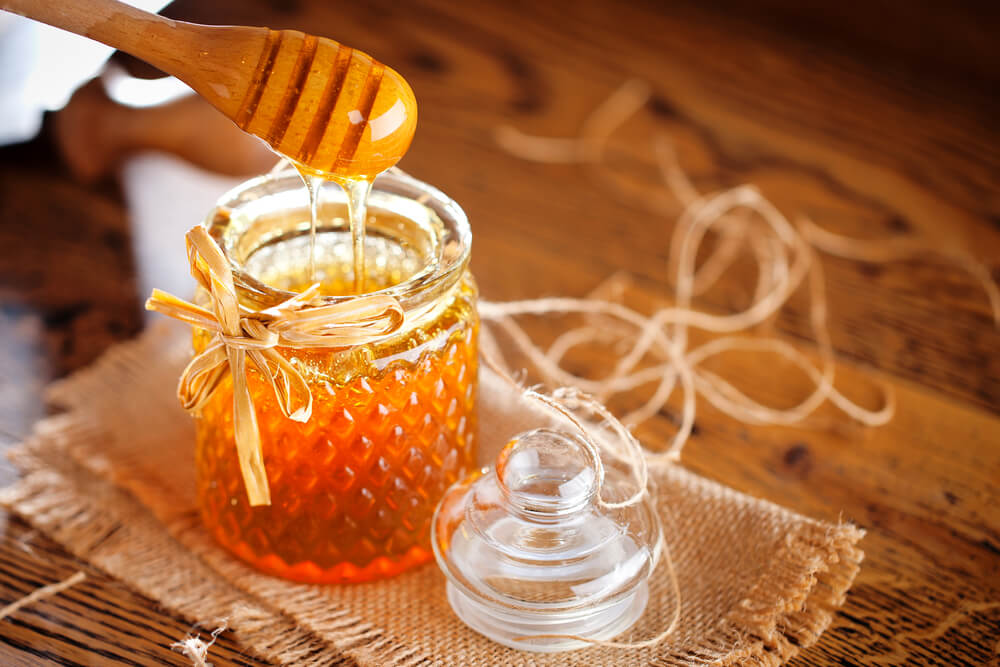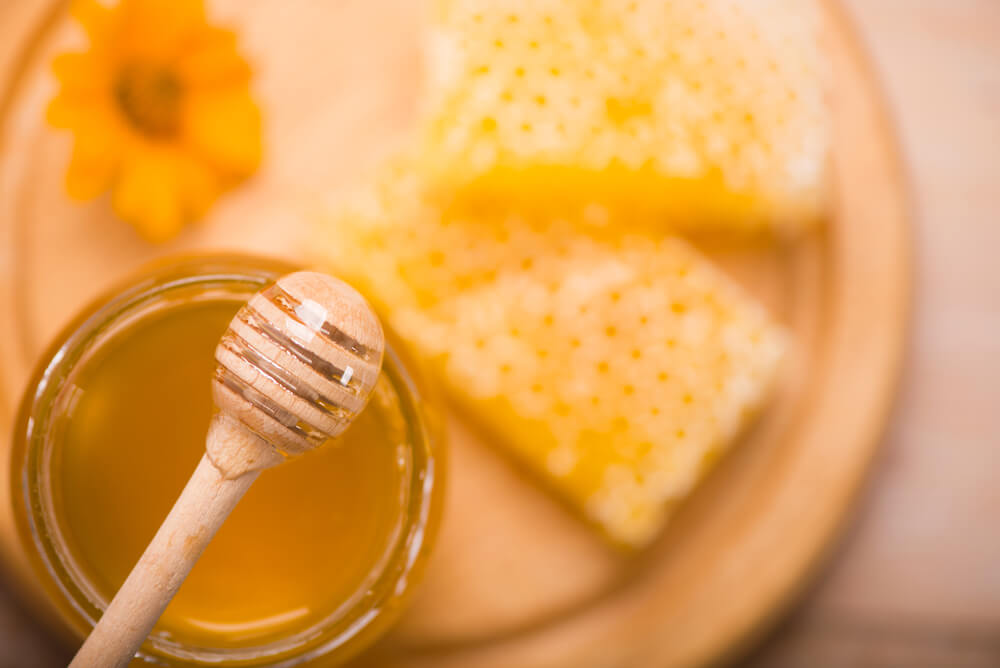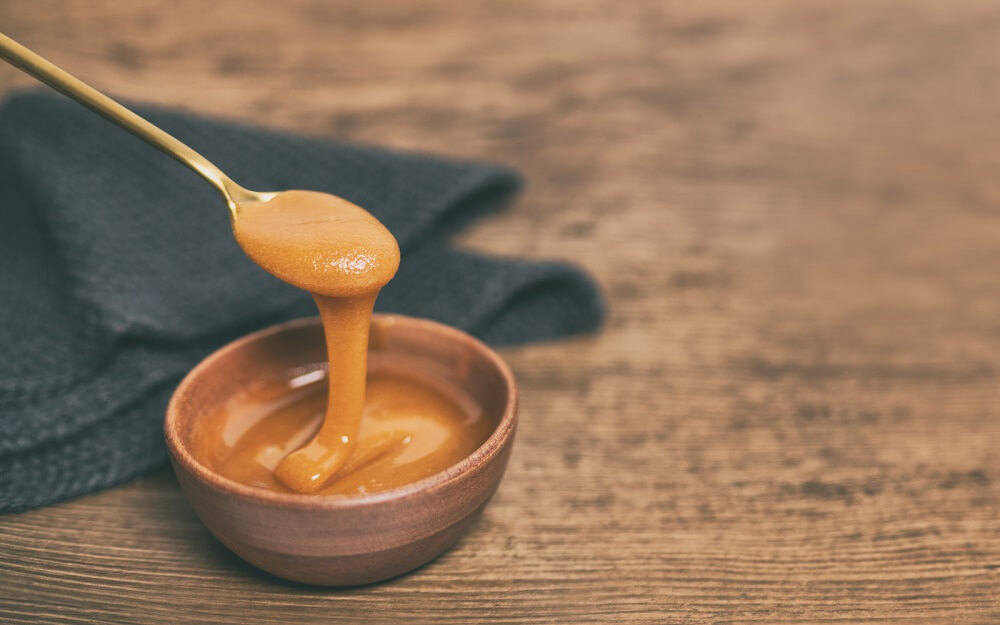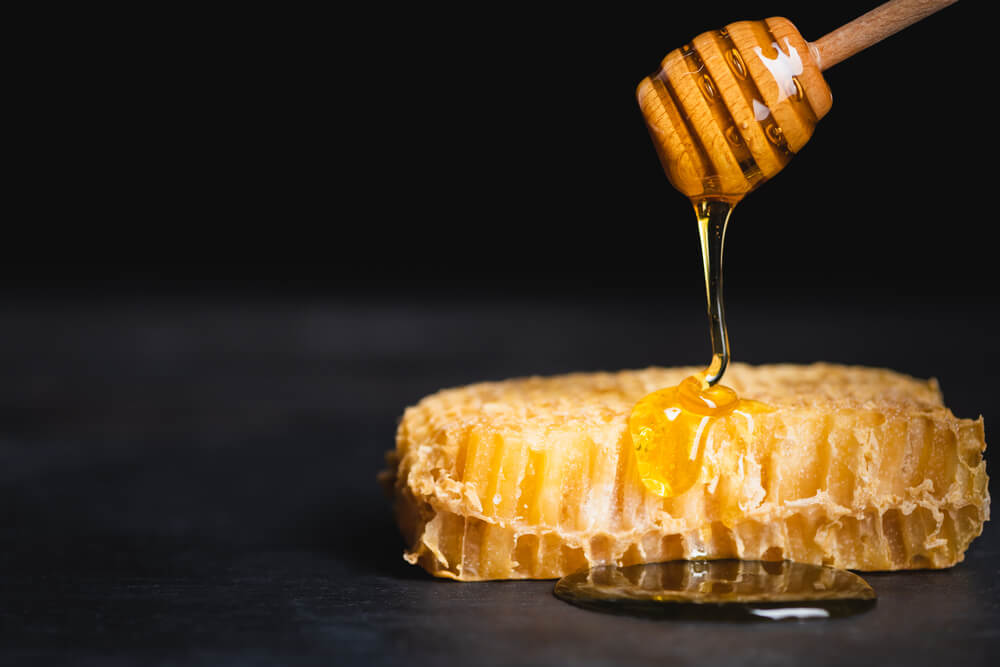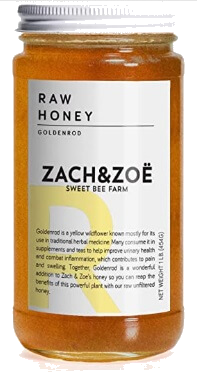Table of Contents:
What is Goldenrod Honey?
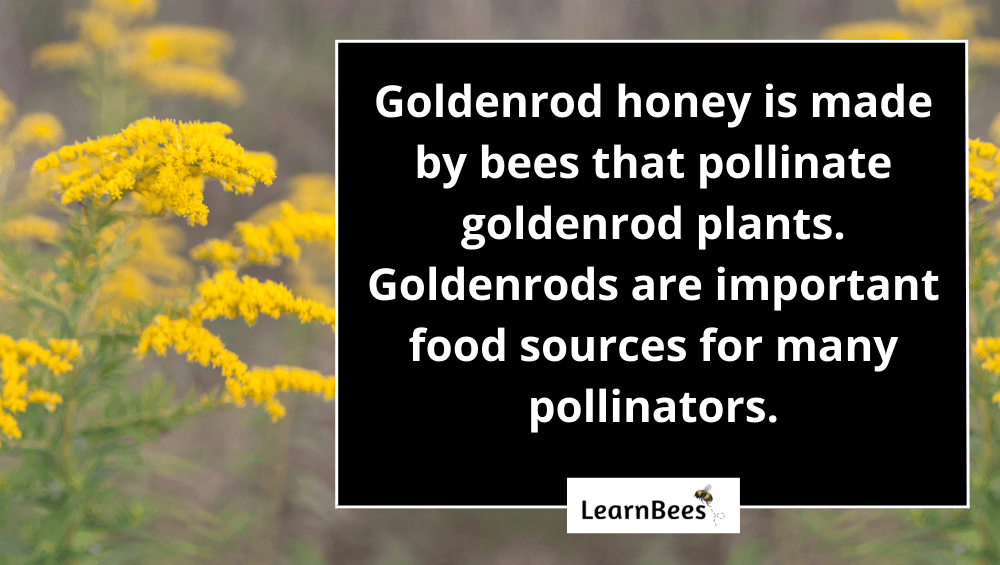
Goldenrod honey is produced by honeybees that feed on goldenrod plants.
Goldenrod is named after its small clusters of yellow flowers. Goldenrods bloom in the late summer, making them a crucial source of food for bees, butterflies, and other pollinators.(1)
But what does goldenrod honey taste like?
It has a medium sweetness with hints of licorice and butterscotch.
The flavor is nice and complex, with subtle spicy undertones. The texture is creamy, spreading easily on warm biscuits, toast, or pancakes.
And here’s the good news:
Raw goldenrod honey is rich in antioxidants and enzymes that can soothe sore throats and coughs. In addition, raw honey is antibacterial and anti-inflammatory, making it useful for wound healing.
But keep in mind:
Only raw honey contains these health benefits – not processed honey with artificial sweeteners.
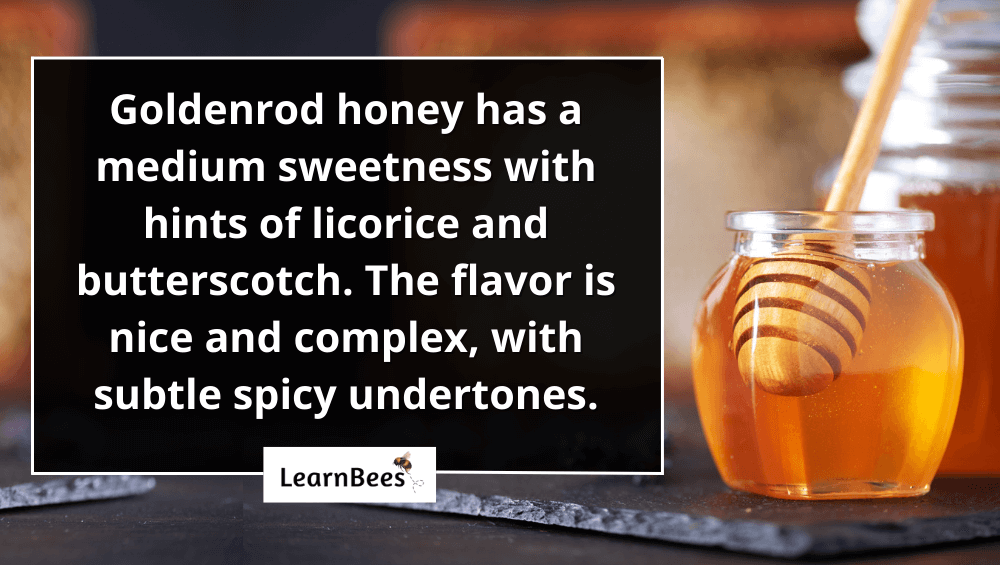
What is raw honey, you ask?
Raw honey is unheated and unprocessed honey. It’s honey straight from the beehive in its natural state.
Why is this important?
Because the nutrients in honey often get filtered out during the pasteurization process. What’s more, some manufacturers dilute honey with artificial sweeteners like high fructose corn syrup.(2, 3)
As a result, overly processed honey is no longer considered real honey, according to the FDA.(4)
But this is where raw goldenrod honey comes in.
Raw honey hasn’t been heated, filtered, or diluted with other sweeteners. It’s left the way honeybees made it.
So here’s our best tip:
If you want to enjoy both the taste and health benefits of honey, raw goldenrod honey is the way to go.
And as a general rule?
Pick honey that says “raw” on the label. Avoid the processed honey that comes in plastic teddy bear containers.
What Are the Benefits of Goldenrod Honey?
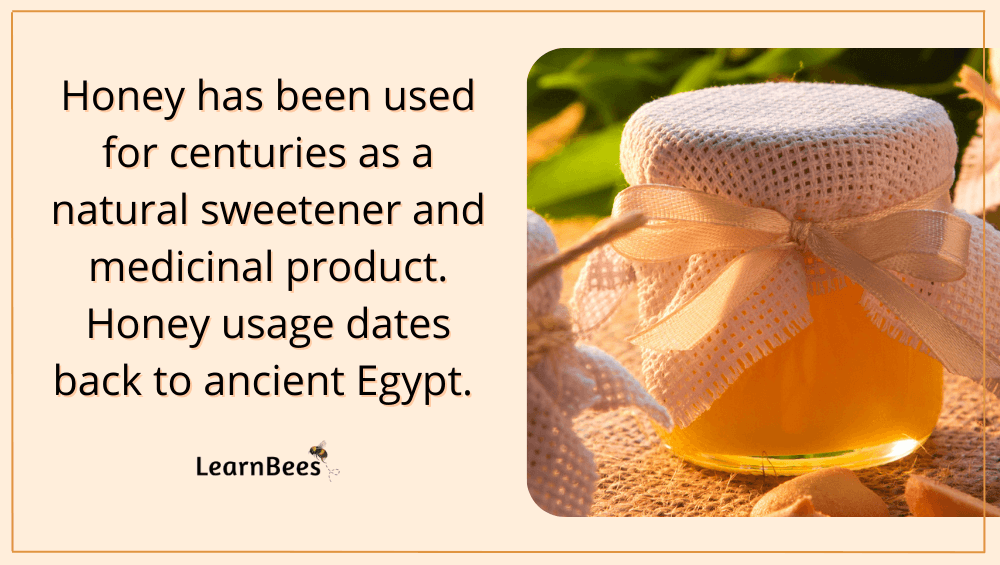
Goldenrod Honey Nutrition
A single tablespoon of goldenrod honey contains:
- Calories: 60 calories
- Protein: 0 grams
- Fat: 0 grams
- Carbs: 17 grams
- Sugars: 16 grams
So what are the goldenrod honey benefits?
Let’s discuss a few:
Benefit 1: Raw Honey Contains Powerful Antioxidants
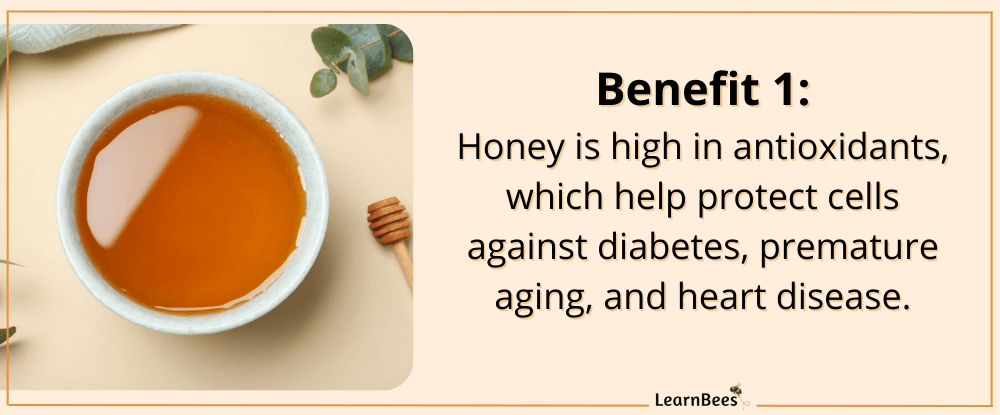
Raw honey contains flavonoids and phenolic acids, which are antioxidants that help the body prevent cell damage. When cells become damaged, they can lead to premature aging, type 2 diabetes, and heart disease.(5)
Raw honey contains antioxidants with anti-inflammatory effects that might aid in preventing illnesses linked to oxidative stress.(6)
Honey may also include bee propolis and pollen, which have been shown to provide health benefits.
Raw honey has also been linked to improvements in the respiratory, gastrointestinal, cardiovascular, and nervous systems.(7)
Benefit 2: Raw Honey Can Heal Wounds like Burns, Cuts, and Scratches

Topical honey treatments are beneficial because of their antibacterial, antifungal, and anti-inflammatory abilities.(8, 9)
Honey has been shown in studies to aid in the healing of burns and sores that develop infections after surgery.(10)
Honey has antimicrobial benefits, according to a review of studies. Honey’s microbial inhibition and wound healing properties were shown to be effective in another study.(11, 12)
Topical honey may be used to help cure diabetes-related foot ulcers. Diabetic ulcers are serious and might result in foot amputation.
Honey was found to have a 43.3% success rate in curing diabetes-related foot ulcers in one study. Topical honey was discovered in another study to heal 97% of participants’ diabetes-caused ulcers.(13)
It’s also been shown to help with other skin conditions, such as psoriasis and herpes sores.(14)
Benefit 3: Raw Honey May Lead to Better Heart Health
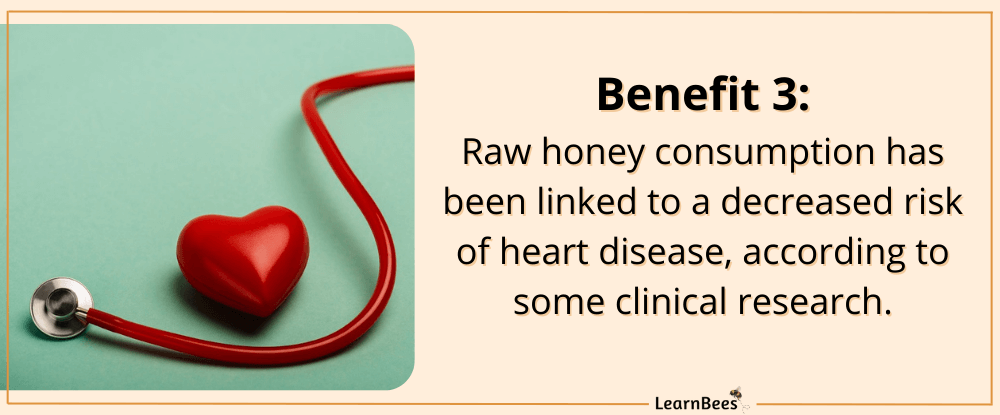
Raw honey has been shown in studies to help prevent heart disease.
Honey consumption was linked to a decreased risk of high blood pressure in women, according to one study of 4,500 people.(15)
Honey is said to decrease blood pressure, regulate your heart rate, and aid in improving blood fat levels. As a result, honey can lead to improved heart health in the long run.(16)
According to a rat study, honey also protects the heart against oxidative stress.(17)
Honey also includes propolis, a resin produced by honeybees from sap-producing trees. Propolis has been shown to have cholesterol and triglyceride-lowering effects.(18)
Benefit 4: Raw Honey Can Ease Coughs and Sore Throats
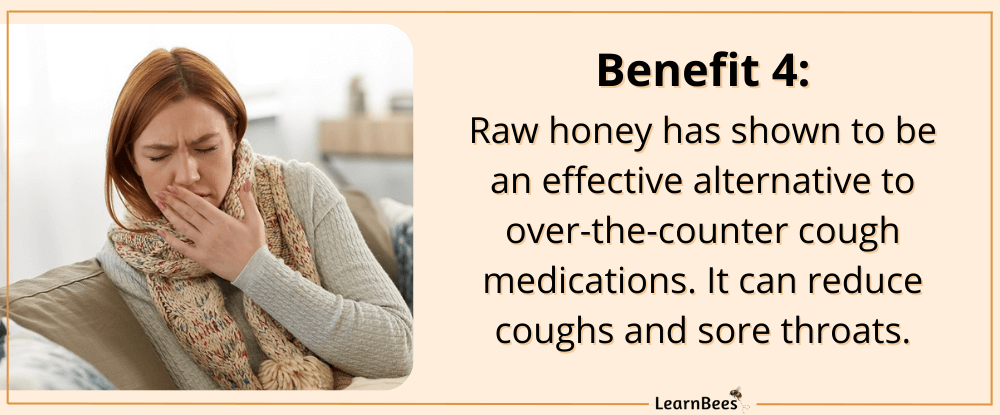
Sore throats and coughing are common symptoms amongst people suffering from upper respiratory infections.
Fortunately, raw honey might be a useful alternative to over-the-counter cough medicines, with evidence suggesting it works.(19)
Honey was found to be more effective than diphenhydramine (a cough medication ingredient) in suppressing cough symptoms. Honey may also help reduce the duration of coughing fits, which is an added benefit.(20)
Honey has been shown in numerous studies to be helpful against upper respiratory issues.(21)
Honey has been found to improve sleep quality in children and parents with coughs, according to another study.(22)
Honey also has the benefit of not causing any negative effects, unlike certain cough medications. However, honey shouldn’t be fed to babies under one year old due to the potential risk of infant botulism.(23)
What Are the Risks of Goldenrod Honey?
The good news is that honey is relatively safe for most people. Both honey and honeycomb are delicious treats.
But are there any side effects of goldenrod honey?
Yes, there are two things to keep in mind:
Risk 1: Raw Honey Isn’t Recommended for Babies under 12 Months Old

Honey can cause infant botulism in children under the age of one.
Botulism is a rare foodborne illness that can sometimes be deadly. It’s caused by bacteria called Clostridium botulinum. Botulism affects the nervous system and can cause paralysis or respiratory failure.
For this reason, it’s best not to give children honey until they’re at least one year old. An infant’s immune system is still developing, and they’re more susceptible to the Clostridium botulinum bacteria.
Risk 2: Honey Can Spike Blood Sugar Levels in People With Diabetes
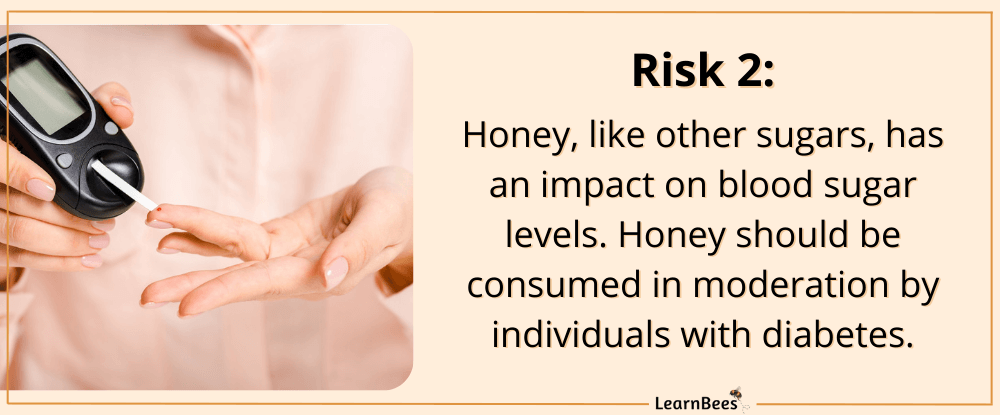
Although honey has numerous health advantages, it does have sugar and carbohydrates. These sugars may cause blood sugar levels to rise in people with diabetes.
People with diabetes must also carefully monitor their carb intake, especially when taking insulin. If you have diabetes and want to eat honey, check with your doctor and watch your blood sugar levels closely.
FAQs on Goldenrod Honey
- What color is goldenrod honey?
- How do you take goldenrod honey?
- Is goldenrod honey safe?
- Is raw goldenrod honey good for you?
- What does goldenrod honey taste like?
- Where does goldenrod honey come from?
- Is goldenrod honey tea good?
- Is goldenrod honey for skin beneficial?
- Where can I buy goldenrod honey?
- Is goldenrod honey vegan?
- Is goldenrod honey poisonous to humans?
- What’s the difference between goldenrod honey vs. wildflower honey?
- What does goldenrod honey smell like?
What color is goldenrod honey?
Goldenrod honey is usually medium golden in color, but it can be slightly darker depending on where the honeybees sourced the goldenrod. There are about 150 species of goldenrod, so this can allow for slight variations in the honey.
—> Go back to the FAQs on goldenrod honey
More to Explore:
How do you take goldenrod honey?
You can take goldenrod honey in various ways. You can enjoy it directly from the spoon, add it to tea or coffee, drizzle it on oatmeal or yogurt, or use it in recipes as a sugar replacement.
—> Go back to the FAQs on goldenrod honey
More to Explore:
Is goldenrod honey safe?
Yes, goldenrod honey is safe for most people.
However, due to the danger of infant botulism, raw honey should not be given to infants under the age of one. Botulism is a rare foodborne illness that can sometimes be deadly. It’s caused by bacteria called Clostridium botulinum.
Once children are older than one, they can safely eat raw honey.
People with diabetes should also be cautious when eating honey, as it can cause blood sugar levels to rise.
—> Go back to the FAQs on goldenrod honey
More to Explore:
Is raw goldenrod honey good for you?
People often ask, “What is goldenrod honey good for?”
Raw honey, in general, has various health benefits. It’s full of antioxidants and enzymes that can help heal wounds, soothe coughing fits, and relieve sore throats. Raw honey has also been shown to fight inflammation associated with serious concerns, such as diabetic-related foot ulcers.
—> Go back to the FAQs on goldenrod honey
More to Explore:
- The Top 3 Best Manuka Honey Brands
- Orange Blossom Honey: Uses, Benefits, & Risks
- Sourwood Honey: Uses, Benefits, & Risks
What does goldenrod honey taste like? Does goldenrod make good honey?
Goldenrod honey has a mild sweetness, with undertones of butterscotch and licorice. The flavor is bold and complex, with hints of spicy undertones. It pairs well with strong cheeses, such as blue cheese. It also goes nicely with nuts and fruits, such as pears and almonds.
—> Go back to the FAQs on goldenrod honey
More to Explore:
Where does goldenrod honey come from?
People often ask:
How is goldenrod honey made? What do honey bees get from goldenrod? Do honey bees get nectar from goldenrod? Do honeybees like goldenrod? Is goldenrod good for pollinators?
Goldenrod honey comes from honeybees. Honeybees are attracted to the small, yellow clusters of flowers that make up the goldenrod plant.
Goldenrod is beneficial for pollinators because it blooms in the late summer. During this time, flowers may not be as present as they are in the spring. Pollinators need to access flowers that bloom throughout the early spring, summer, and fall.
When the bees land on the goldenrod flowers, they collect the nectar inside, which they then take back to their hive. Once at the hive, the bees deposit the nectar into honeycombs.
The bees then fan their wings over the honeycomb to evaporate the water from the nectar. Once most of the water has evaporated, the bees seal off the honeycomb with beeswax.
Honeybees will later eat their honey during the winter when they don’t have access to pollen and nectar from flowers.
—> Go back to the FAQs on goldenrod honey
More to Explore:
- The Brutally Honest Truth About Sour Honey
- Buckwheat Honey: Uses, Benefits, & Risks
- Can You Eat Honeycombs?
Is goldenrod honey tea good?
Yes, goldenrod honey tea is delicious. Goldenrod honey has a mild sweetness that pairs well with tea or coffee. It won’t overpower the drink. Instead, it complements the tea nicely and enhances the natural flavors.
—> Go back to the FAQs on goldenrod honey
More to Explore:
Is goldenrod honey for skin beneficial?
Yes, there is evidence to suggest that raw honey, in general, can be beneficial for the skin. For example, raw honey can promote wound healing and prevent harmful bacteria that lead to infections.
You can apply goldenrod honey directly to the skin on burns, scratches, or cuts. You can also use honey as a face mask, leaving it on for a few minutes before washing it off.
—> Go back to the FAQs on goldenrod honey
More to Explore:
Where can I buy goldenrod honey?
Depending on where you live, you can purchase raw goldenrod honey from a local beekeeper. You can also buy raw goldenrod honey online.
—> Go back to the FAQs on goldenrod honey
More to Explore:
Is goldenrod honey vegan?
No, goldenrod honey is a by-product of honeybees, so it isn’t considered vegan.
Keep in mind that there are over 300 different kinds of honey. None of them are vegan because they’re all produced by honeybees.
“Vegan-friendly” honey is not genuine honey produced by honeybees. Instead, it’s a sweet syrup made by humans.
—> Go back to the FAQs on goldenrod honey
More to Explore:
Is goldenrod honey poisonous to humans?
No, goldenrod honey is safe for most adults to consume.
The exception is for children under 12 months old. Children under one year shouldn’t eat honey because it can lead to a potentially fatal condition called infant botulism. Once the child is older than 12 months, they can safely consume honey because their immune system has matured enough to fight off harmful bacteria.
And as with any food product, there is always a risk of allergic reaction. If you’re allergic to bee stings or pollen, try honey in small amounts to ensure you don’t react to the honey.
If you have diabetes, be aware that honey contains natural sugars that can elevate your blood sugar.
—> Go back to the FAQs on goldenrod honey
More to Explore:
What’s the difference between goldenrod honey vs. wildflower honey?
Wildflower honey is made from the nectar of multiple flowers, while goldenrod honey is made from just the nectar of the goldenrod plant. This means the two types of honey will taste differently.
For example, wildflower honey comes from plants that grow naturally in the wild. There are thousands of wildflower species, so the honey can vary depending on where the bees sourced the wildflowers.
Wildflower honey is often described as sweet with fruity undertones. But again, the flavor of wildflower honey can vary depending on the time of year and the location of the wildflowers.
—> Go back to the FAQs on goldenrod honey
More to Explore:
- Honey for Skin Benefits: Directions, Uses, & Risks
- Allergic to Honey: Signs of a Honey Allergy + Treatment
- Why is Manuka Honey So Expensive?
What does goldenrod honey smell like?
Some people describe goldenrod honey as having a “stinky cheese” smell. This is usually when the honey is first produced by the honeybees and is still in the beehive.
Thankfully, most packaged goldenrod honey loses that smell over time. It develops a mild aroma with licorice undertones.
